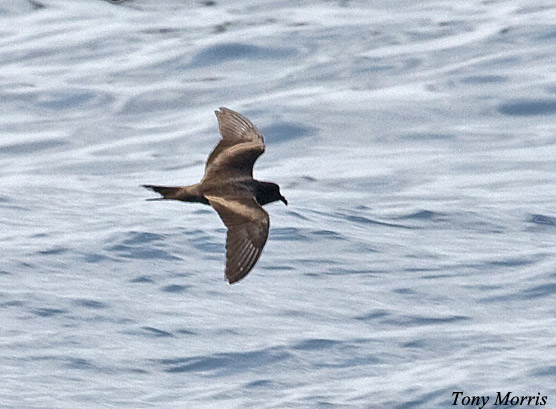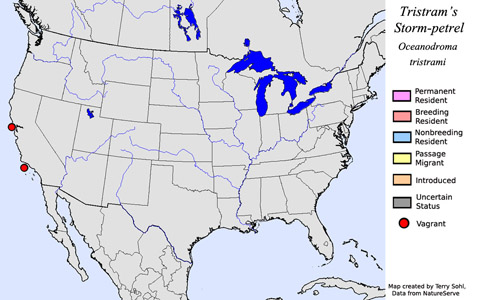| Length: 7-8 inches | Wingspan: 17-18 inches | Seasonality: Non-resident in South Dakota |
| ID Keys: Dark overall, pale gray bar on upper wings, paler rump than rest of body, notched tail | ||
 Tristram's
Storm-petrel, also sometimes called the Sooty Storm-petrel, has a normal
range in the north Pacific ocean, typically in tropical areas. In
North America, they are known for a handful of records off the west coast of
the U.S., including a bird in the Farallon Islands and at Santa Rosa Island
off the coast of California. The species mostly breeds in the Hawaiian
Island chain, as well as a few islands off the coast of Japan. They
have a small breeding range to begin with, and the introduction of rats and
other introduced species on some of their former breeding islands has
further reduced suitable breeding habitat. In Japan, breeding is now
reduced to 3 very small, rat-free islands. In Hawaii, it is thought
they once had a greater breeding distribution such as on Midway Island, but
the introduction of rats likely decimated any breeding populations there.
The global population of Tristram's Storm-petrel is likely below 30,000
birds. They are protected in the Hawaiian Islands and current
populations are considered stable, but they are still considered a
"threatened" species.
Tristram's
Storm-petrel, also sometimes called the Sooty Storm-petrel, has a normal
range in the north Pacific ocean, typically in tropical areas. In
North America, they are known for a handful of records off the west coast of
the U.S., including a bird in the Farallon Islands and at Santa Rosa Island
off the coast of California. The species mostly breeds in the Hawaiian
Island chain, as well as a few islands off the coast of Japan. They
have a small breeding range to begin with, and the introduction of rats and
other introduced species on some of their former breeding islands has
further reduced suitable breeding habitat. In Japan, breeding is now
reduced to 3 very small, rat-free islands. In Hawaii, it is thought
they once had a greater breeding distribution such as on Midway Island, but
the introduction of rats likely decimated any breeding populations there.
The global population of Tristram's Storm-petrel is likely below 30,000
birds. They are protected in the Hawaiian Islands and current
populations are considered stable, but they are still considered a
"threatened" species.
The few birds found off the coast of California may be an indicator of warming ocean currents in the region, given the species preference for warm-water areas outside of the breeding season.
Habitat: Outside of the breeding season they can be found widely over warm, tropical or subtropical waters of the central and western Pacific Ocean. During breeding season, they are found on small islands where introduced species such as rats or cats are not a problem.
Diet:Diet: Mostly feeds on fish and squid, as well as crustaceans and insects.
Behavior: Forages mostly at night, gliding close to the water's surface searching for food items. "Patters" on the water surface as do other storm-petrels.
Nesting: Colonial nester. Nests are burrows dug in sandy areas, in rocky crevices, or under a clump of vegetation. Young typically do not fledge until 10 to 12 weeks after hatching.
Migration: Breeds in the winter on the Hawaiian Islands and a few invasive-free small islands of Japan. Outside of the breeding season, they can range widely across the Pacific Ocean, staying over warmer tropical and sub-tropical waters.
Interactive eBird Map: Click here to access an interactive eBird map of Tristram's Storm-petrel sightings
Conservation Status: The IUCN lists the Tristram's Storm-petrel as "Near Threatened". However, breeding locations in the Hawaiian Islands are protected, and the species is currently considered to have a stable population. The eradication of introduced rats and other species may aid the Tristram's Storm-petrel. Rats have now been exterminated from Midway atoll, and while breeding has not been confirmed, Tristram's Storm-petrels are now being caught in mist-netting operations there.
Further Information: 1) American Bird Conservancy Watchlist - Tristram's Storm-petrel
2) BirdLife International - Tristram's Storm-petrel
3) Marine Ornithology Manuscript - Breeding Biology of Tristram's Storm-petrel in the Hawaiian Islands
Photo Information: Photo taken by Tony Morris - April 25th, 2012 - Off the coast of Japan - Photo licensed under Creative Commons Attribution NonCommercial 2.0 Generic License.
| Click below for a higher-resolution map |
 |
| South Dakota Status: Non-resident in South Dakota |
Additional Tristram's Storm-petrel Photos (coming soon!!)
